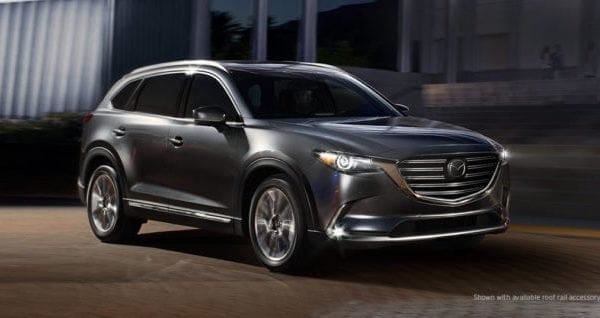
The Mazda CX-9 comes in three trim levels, with either front-wheel drive or all-wheel drive, and transmission is a six-speed automatic only. And the styling draws plenty of praise
The CX-9 is the biggest model Mazda makes and arguably the most interesting.
Not because it’s extraordinarily fast or has bling styling, or even because it pampers its occupants more than anyone else. On the face of it, the CX-9 is yet another mid-size SUV, duking it out in one of the most competitive markets in the industry.
Tipping the scales at 1,981 kilograms (4,367 pounds) with a 293-centimetre (9.6 feet) wheelbase and seating for seven adults, the 2018 CX-9 is powered by a turbocharged 2.5-litre, four-cylinder engine that’s part of Mazda’s SkyActive engineering program. What makes this engine stand out is:
- it’s about as large as a four-banger can get without posing significant engineering challenges;
- it has comparatively high compression;
- it features different horsepower outputs, depending upon the grade of fuel used.
This last item shows a 23-horsepower difference between 93 octane and regular 87 gas. That in itself is noteworthy. Most other manufacturers just say it takes premium gas. Period. The CX-9 will run happily on regular but if you want that extra bit of zip, it’s happy to take the good stuff. Curiously, torque output remains the same regardless of fuel. I tried both grades and honestly, couldn’t discern a huge difference. Premium may be a bit livelier.
The CX-9 comes in three trim levels, with either front-wheel drive or all-wheel drive, and transmission is a six-speed automatic only. Both the front-wheel and all-wheel-drive models have the same towing capacity (1,588 kilograms or 3,500 pounds), and the front-wheel model has a slightly smaller fuel tank than its all-wheel stablemate.
Cargo capacity is 2,017 litres (103 cubic feet) with all the seats folded, and the seats easily fold down via a top-mounted lever. Comparatively, the Honda Pilot has about 3,090 litres, while the Hyundai Santa Fe offers 2,025 litres. I play in a blues band and can testify that the CX-9 will accommodate all my drum gear, plus a couple of amps, speakers, switchboards, three guitars, small suitcases, guitar player and a sleepy harp player no problem. I don’t think that was the general idea when Mazda designed the CX-9, but it’s got plenty of room if needed.

The Mazda CX-9 has almost zero noise, vibration or harshness – carrying on a conversation while highway driving is no problem. And it has more than adequate cargo capacity, seating seven adults
A few highlights:
• Power is abundant and handy. It may lack the bottom-end grunt of a V6 or V8, but the four-cylinder is willing and, to a point, quick to respond. It seems to peak quickly but for most conditions, it’s more than enough. This engine is also one of the quietest and best-behaved I’ve encountered in awhile. A nice piece of engineering.
• The CX-9 is possibly the quietest SUV I’ve ever driven. Almost zero in the way of NVH (noise, vibration, harshness) and carrying on a conversation while highway driving is no problem.
• Loved the driveability of this one but really question the logic of the switchgear. For example, changing radio stations involves bringing up the radio band, scrolling over to the appropriate function and then turning the dial. Three steps. Why? This is actually an issue with most Mazda products and it sucks.
• This car may have the most hyperactive automatic locking system in the world. As soon as you get out of the vehicle, it locks itself and you often find yourself fumbling around with the key fob just to get back in. I understand the purpose behind this but it’s really, really, really annoying.
• I had several queries from other people about the styling of this one while driving it and all favourable. SUVs don’t normally get people worked up when it comes to visuals but the CX-9 seems to strike a chord.
Compared to the overwhelming popularity of models like the Hyundai Santa Fe, Honda Pilot and Toyota Highlander, the CX-9 kind of flies under the radar. It’s not a huge seller but, considering its overall quality and usability, it could be.
But let’s do something about the switchgear and automatic locking.
2018 Mazda CX-9
Engine: 2.5-litre turbocharged four-cylinder
Transmission: six-speed automatic
Drive: front-wheel and all-wheel
Horsepower: 250/227 at 5,000 rpm
Torque: 310 feet pounds at 2,000 rpm
Price range: $36,400 to $47,300
Fuel economy: 11.5 litres/100 kilometres (city) and 8.9 (highway), all-wheel-drive model. Regular or premium fuel..
Some alternatives: Honda Pilot, Toyota Highlander, Hyundai Santa Fe, Kia Sorento, Ford Explorer, VW Atlas, Nissan Rogue, Chevrolet Equinox.
Ted Laturnus writes for Troy Media’s Driver Seat Associate website. An automotive journalist since 1976, he has been named Canadian Automotive Journalist of the Year twice and is past-president of the Automotive Journalists Association of Canada (AJAC).
The views, opinions and positions expressed by columnists and contributors are the author’s alone. They do not inherently or expressly reflect the views, opinions and/or positions of our publication.
This site is Powered by Troy Media Digital Solutions

